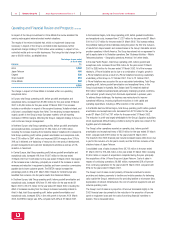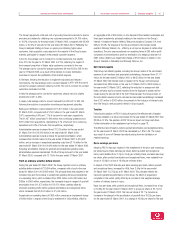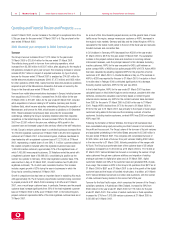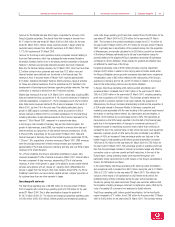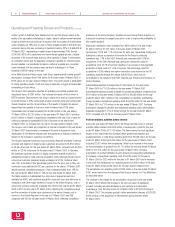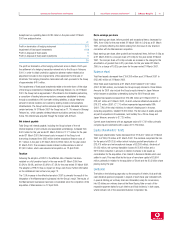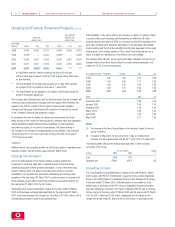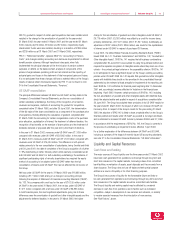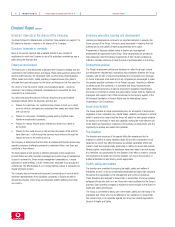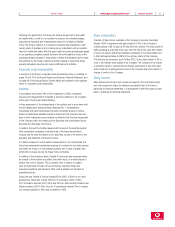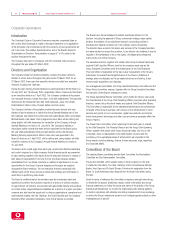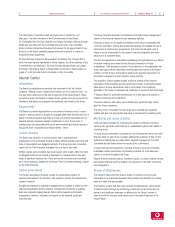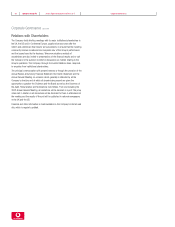Vodafone 2002 Annual Report Download - page 48
Download and view the complete annual report
Please find page 48 of the 2002 Vodafone annual report below. You can navigate through the pages in the report by either clicking on the pages listed below, or by using the keyword search tool below to find specific information within the annual report.
Vodafone Group Plc Annual Report & Accounts and Form 20-F Operating and Financial Review and Prospects46
Operating and Financial Review and Prospects continued
The above table excludes commitments in respect of put options over
certain interests in Group businesses held by minority shareholders.
Further details are provided in note 28 to the Consolidated Financial Statements,
“Capital commitments”.
Financial assets and liabilities
Details of the Group’s treasury management and policies are set out below in
“Quantitative and Qualitative Disclosures About Market Risk”. Analyses of
financial assets and liabilities, including the maturity profile of debt, currency and
interest rate structure, are included in notes 20 and 21 to the Consolidated
Financial Statements included in this Annual Report.
Quantitative and Qualitative Disclosures About
Market Risk
The Group’s treasury function provides a centralised service to the Group for
funding, foreign exchange, interest rate management and counterparty risk
management. Treasury operations are conducted within a framework of policies
and guidelines authorised and reviewed annually by the Board of the Company.
The Group accounting function provides regular update reports of treasury
activity to the Board. The Group uses a number of derivative instruments that are
transacted, for risk management purposes only, by specialist treasury personnel.
The internal control environment is reviewed regularly by the Group’s internal
auditors. There has been no significant change during the financial year, or since
the end of the year, to the types of financial risks faced by the Group or the
Group’s approach to the management of those risks.
Funding and liquidity
The Group’s policy is to borrow centrally, using a mixture of long term and
short term capital market issues and borrowing facilities, to meet anticipated
funding requirements. These borrowings, together with cash generated from
operations, are lent or contributed as equity to subsidiaries. The Board has
approved ratios consistent with those used by companies with high credit ratings
for net interest cover, market capitalisation to net debt and EBITDA to net debt,
which establish internal guidelines for the level of debt that the Group may have
outstanding. These ratios are shared with the credit rating agencies. For the
2002 financial year, Group interest, excluding the Group’s share of interest
payable by joint ventures and associated undertakings, is covered 16.2 times by
Group EBITDA plus dividends from joint ventures and associated undertakings.
Group EBITDA, before exceptional items, is the operating loss/profit of the
Company and its subsidiary undertakings before exceptional costs, plus
depreciation and amortisation.
Interest rate management
The Group’s main interest rate exposures are to pounds sterling, euro and yen
interest rates. Under the Group’s interest rate management policy, interest rates
are fixed when net interest is forecast to have a significant impact on profits.
Therefore, the term structure of interest rates is managed within limits approved
by the Board, using derivative financial instruments such as swaps, futures,
options and forward rate agreements. At the end of the year, 38% (2001: 72%)
of the Group’s gross borrowings were fixed for a period of at least one year.
Based on all interest rate sensitive instruments, a one hundred basis point rise in
market interest rates for all currencies in which the Group had borrowings at
31 March 2002 would affect profit before taxation by approximately £80 million.
The interest rate management policy has remained unaffected by the
acquisitions completed during the financial year, although there has been an
increase in the weighting of the exposure to yen interest rates as a consequence
of the Group achieving control of Japan Telecom and the J-Phone Group.
Foreign exchange management
Foreign currency exposures on known future transactions are hedged, including
those resulting from the repatriation of international dividends and loans.
Forward foreign exchange contracts are the derivative instrument most used
for this purpose.
A 10% strengthening of sterling against all currencies in which the Group’s
international net earnings are denominated would reduce the 2002 total Group
operating loss by £1,156 million (2001: reduction in total Group operating loss
by £707 million).
The Group’s policy is not to hedge its international assets with respect to
foreign currency balance sheet translation exposure, since net tangible assets
represent a small proportion of the market value of the Group and international
operations provide risk diversity. However, 95% of net borrowings were
denominated in currencies other than sterling in anticipation of cash flows from
profitable international operations and this provides a partial hedge against profit
and loss account translation exposure. A relative strengthening in the value of
sterling against certain currencies of countries where the Group operates has
resulted in a currency translation adjustment of £2,263 million charge to Group
reserves in the year ended 31 March 2002 (2001: £5,172 million credit).
Counterparty risk management
Cash deposits and other financial instrument transactions give rise to credit risks
on the amounts due from counterparties. The Group regularly monitors these
risks and the credit ratings of its counterparties and, by policy, limits the
aggregate credit and settlement risk it may have with one counterparty. While the
Group may be exposed to credit losses in the event of non-performance by these
counterparties, it considers the possibility of material loss to be minimal because
of these control procedures. Additional information is set out in notes 20 and 21
to the Consolidated Financial Statements.
Research and Development, Patents and
Licences, etc.
Historically, the Group has viewed itself primarily as a user rather than a principal
developer of technology. However, during the 2001 financial year, it created a
new Group Research and Development (“R&D”) function to increase its influence
on the development of the technology it will use in the future and as a centre of
excellence in applied research in mobile communications and its applications.
The new function was built on the research and development capability that
already existed within the Group, with the addition of new satellite centres of
excellence in areas of technology development of particular significance to the
mobile communications business. The Group R&D function became fully
operational in April 2001. It initially consisted of four centres, one in each of the
UK, the Netherlands, Germany and the US, but two centres of excellence were


